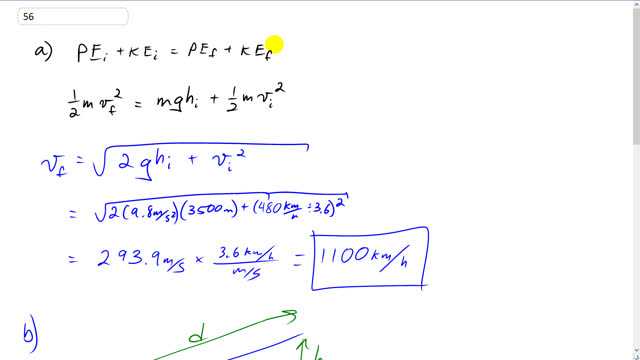
Early test flights for the space shuttle used a “glider” (mass of 980 kg including pilot). After a horizontal launch at 480 km/h at a height of 3500 m, the glider eventually landed at a speed of 210 km/h.
- What would its landing speed have been in the absence of air resistance?
- What was the average force of air resistance exerted on it if it came in at a constant glide angle of to the Earth’s surface?

In order to watch this solution you need to have a subscription.
This is Giancoli Answers with Mr. Dychko. The total initial energy of this glider has to equal the total mechanical energy after it hits the ground or lands, I should say. So, the final energy will consist only of its kinetic energy and maybe some gravitational potential although we'll take the ground to be the reference level in which case, there's no gravitational potential energy at all. And also, none of the energy turns into heat because we are assuming no friction for part (a). So, we have one-half mass times final velocity squared, that's the kinetic energy, equals mgh initial— initial gravitational potential energy— plus one-half mass times initial velocity squared, that's the initial kinetic energy. And we can solve this for v final by dividing everything by m and multiplying both sides by 2 and we get, after taking the square root, the final velocity equals square root of 2 times g initial height plus initial velocity squared. So that's square root of 2 times 9.8 meters per second squared times 3500 meters— initial launch height— plus 480 kilometers per hour converted into meters per second by dividing by 3.6 and square that result and we get our answer. Now since we did this conversion into meters per second and these two things are in meters and seconds that means our answer is in meters per second. So we times it by 3.6 kilometers per hour for every meters per second and we get 1100 kilometers an hour when you round that to two significant figures. Now that will be the final velocity of the glider when it lands in the absence of friction. For part (b), we do have friction and we are told what the final speed is on landing - 210 kilometers an hour. And we are told the initial height and the angle of descent. And we need to figure out this distance over which friction acts in order to figure out its force because the formula for the amount of energy lost to friction is the friction force multiplied by the distance. So, this hypotenuse of this triangle we can figure it out by knowing that sin Θ is the opposite leg of this right triangle divided by the hypotenuse and then multiply both sides by d and divide by sin h or sin Θ, I should say and you get d is h over sin Θ. And then we'll substitute that in for d here. So, we have the total initial equals the total final energy; there's no potential energy in the end when it gets to the ground because this is the reference level. And we are gonna solve all of this for v final. So or sorry, force of friction is what we are looking for here. So let's get this term over to the left-hand side. and you can factor out the m and it's gonna be m times gh initial plus this term but it's v initial squared divided by 2 and then this is v final squared and it's gonna be a minus because we are moving it to the left side. So minus v final squared and it's also divided by 2 so it has a common denominator and you can just write the difference divided by 2. And the m that's multiplied by each of these velocity squared's is outside the bracket here. And switch the sides around so we have the unknown, force of friction, on the left. Then we'll multiply both sides by sin Θ over h and then it cancels on the left solving for force of friction and it appears on the right here. So we have all of this - force of friction is mass times sin of the angle of descent divided by the height it was initially launched from times g times initial height plus initial velocity squared minus final velocity squared all divided by 2 and let's plug that into our calculator and see what happens. 980 kilograms—mass of the glider—times sin of 12 degrees divided by 3500 meters—initial height— times 9.8 times 3500 plus bracket; we need a couple of brackets here actually, this bracket is gonna contain the 480 divided by 3.6 to convert it into meters per second and then we square that result minus 210 divided by 3.6, square that result, converted both those kilometers per hour into meters per second and then close bracket for this whole numerator and then divide it by 2 and then close bracket again for this part here and we get that. And with two significant figures, that would be about 2400 newtons must be the average friction force.